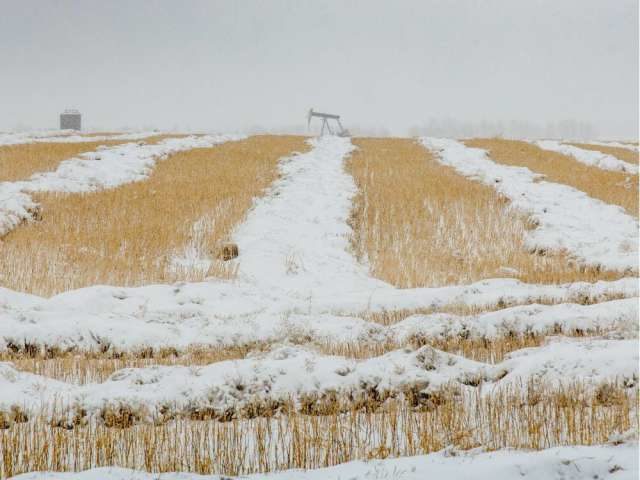
The year's final crop report, released Thursday, shows 93 per cent of crops combined. That's up from 90 per cent on Oct. 28 but well below averages in previous years, where up to 99 per cent of crops were completely harvested by the end of October. Of the province's canola — a valuable cash crop — nine per cent is unharvested.
"Most farmers we're speaking to are holding off until spring," crops extension specialist Cory Jacob said in an interview with Postmedia last week.
Crops that were harvested are almost all of below-average quality, which Jacob said was the culmination of a year of bad weather that began with a spring too dry for germinating followed by a winter too wet and snowy for harvesting.
Jacob said those wet conditions are responsible for slow progress later in the season, though some farmers continue to try and harvest.
"If it warmed up to 10 degrees and then we melted all the snow, and then it freeze-dried down to -15, then we might be able to combine," Jacob said. "But it's pretty hard to fight with these conditions."
That's especially true for crops like soybeans, which are typically harvested near the end of the season.
Jacob estimates millions of acres will go unharvested. What is left in the spring may be damaged and devalued.
Shawn Jake, president and CEO of the Saskatchewan Crop Insurance Corporation, said typically only around 100,000 acres go unharvested. He stressed some regions fared better than others, with many reporting above-average yields. According to the crop report, the southwest and west-central regions both reported 97 per cent of crops harvested while the northeast reached 98 per cent. The region with the worst harvest was the east-central region, with only 83 per cent harvested.
"I know there's going to be problems out there, but there's also some good news stories from producers," Jake said.
"I've seen some farms that could be within 10 miles of each other and there could be a difference. It just depends on how the rain showers went."
Farmers had until Nov. 15 to file a declaration of their yield or extend insurance in case they still had unharvested acres. Saskatchewan Crop Insurance Corporation insures 30 million acres, or roughly 78 per cent, of the province's farmland.
Agricultural Producers of Saskatchewan Association president Todd Lewis suspects many producers may suffer a hit to their bottom line because their yields will be below what they expected but not high enough to trigger a crop insurance payment.
"It's not all doom and gloom," Lewis said. "Hopefully some of us will be able to break even this year, or even make a profit."
Jake said there were over 1,300 applications for the AgStability program this July. The program, which is distinct from crop insurance, triggers a payment when farmers' total revenues are significantly less than expected. He said farmers with reports of degradation, unharvested acres or wildlife damage who have not already reported should immediately do so.
Lewis said his association will vote in early December on whether to lobby the federal government for financial compensation in light of profits due to trade conflicts with China and other countries, which he says has exacerbated the hit to farmers' bottom lines.
"We see it as a responsibility of the government to mitigate the damage caused by trade here," Lewis said.



Canola and soy are junk food anyway. Bison is a native species, adapted to the harsh prairie climate, and produce tons of high quality protein.
Seriously.